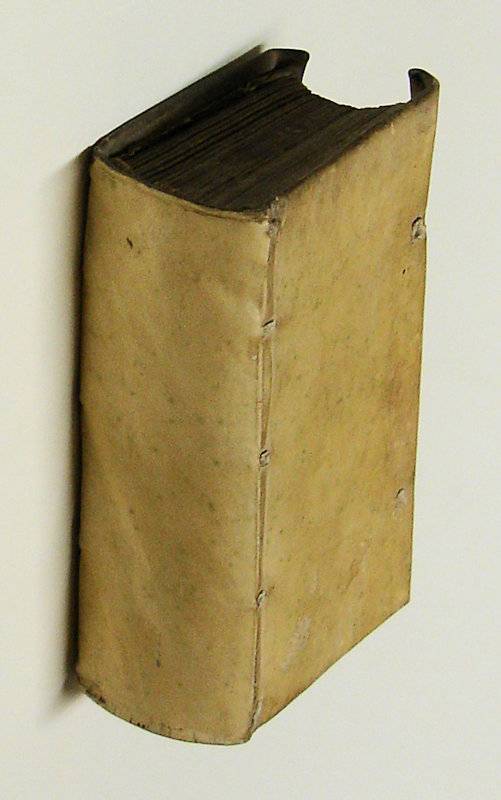SA, MANUEL DE.
Aphorismi confessariorum ex doctorum sententiis collecti, auctore Emanuele Sa Lusitano, doctore Theologo Societatis Iesu. Nunc accurate expurgati a Reverendiss,. P.M. Sacri Palatii Apost. Indicatis Doct. locis, annotationibusque per Andream Victorellum Bass. Theol. illustrati & aucti. Permissu Superiorum. Editio ultima prioribus correctior.
Köln (Coloniae), Apud Ioannem Crithium, Sub signo Galli, 1612.
12mo. (IV),650,(14 indices) p. Overlapping vellum 14 cm (
Details: 5 thongs laced through the joints. Woodcut printer's mark of the Jesuit Order on the title) (
Condition: Vellum age-tanned. All four ties gone. Outer edge of the first and last two leaves are slightly thumbed) (
Note: The Portuguese Jesuit theologian and Biblical scholar Manuel de Sá, 1530-1596, (the latinized form is Emanuel Sa) has written three important works, which were repeatedly published in most European countries well into the seventeenth century: 'Scholia in Quatuor Evangelia', 'Notationes in totam Scripturam Sacram' and the 'Aphorismi confessariorum'. In 1557 he was appointed professor at the Roman College at Rome, where he lectured on the prophecies of Osee, one of the minor prophets, and the 'Summa' of Thomas Aquinas. Pope Pius V appointed De Sa as a member of the commission in charge of preparing an authentic edition of the Septuagint. His last work, the 'Aphorismi confessariorum', first published in Venice in 1595, is considered to be his most important work. In it the entries are arranged as in encyclopedias in alphabetical order. The word 'aphorism' on the title has little to do with the meaning that we give it today. For instance, under the heading 'Episcopus', De Sa offers 43 quotes from different authorative sources to explain the duties and power of a bishop. In 1603 the 'Aphorismi confessariorum' were censured and placed on the 'Index Librorum Prohibitorum' of the Catholic Church, in English, 'List of Banned Books', a list of publications deemed heretical or anti-clerical. This was done apparently because the 'Master of the Sacred Palace' (Magister Sacri Palatii) thought some of its maxims not in line with opinions commonly held among catholic theologians. As the title of this 1612 edition shows, it was later corrected (nuper accurate expurgati) and removed 'permissu Superiorum' from the Roman Index. The work was for some decades very popular. Between 1595 and 1632 almost every year somewhere a new edition was printed. The Cologne printer Crithius alone published this work in 1600, 1609, 1612, 1615 and 1621. It was even published in Tokyo in 1603) (
Collation: Ò2, A-Z12, Aa-Dd12, E8) (Photographs on request)
Book number: 120149 Euro 250.00
Keywords: (Oude Druk), (Rare Books), Theologie, religion, theology
 SA, MANUEL DE.
SA, MANUEL DE.